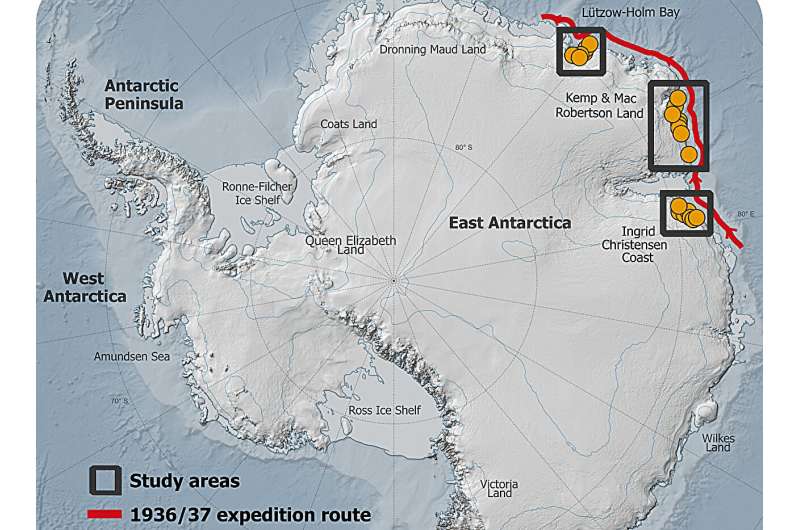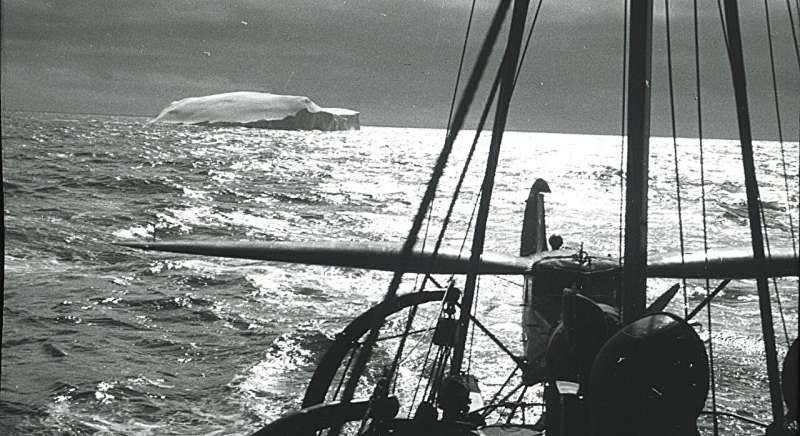Overview map. Credit: Mads Dømgaard
A whaler's forgotten aerial photos from 1937 have given researchers at the University of Copenhagen the most detailed picture of the ice evolution in East Antarctica to date. The results show that the ice has remained stable and even grown slightly over almost a century, though scientists observe early signs of weakening. The research offers new insights that enhance predictions of ice changes and sea level rise.
Higher temperatures, extreme weather, melting glaciers, and rising sea levels—all indicators that the climate and the world's ice masses are in a critical state. However, a new study published in Nature Communications from the Department of Geosciences and Natural Resource Management at the University of Copenhagen offers a local bright spot.
Using hundreds of old aerial photographs dating back to 1937, combined with modern computer technology, the researchers have tracked the evolution of glaciers in East Antarctica. The area covers approximately 2,000 kilometers of coastline and contains as much ice as the entire Greenland Ice Sheet.
By comparing the historical aerial photos with modern satellite data, the researchers have been able to determine whether the glaciers have retreated or advanced and whether they have thickened or thinned. The study reveals that the ice has not only remained stable but grown slightly over the last 85 years, partly due to increasing snowfall.
"We constantly hear about climate change and new melt records, so it's refreshing to observe an area of glaciers that has remained stable for almost a century," says Ph.D. student Mads Dømgaard, the study's first author.
However, the researcher emphasizes that the study also shows the first signs of changes in the sea ice off the glacier. This could mean that the stable East Antarctic glaciers might shrink in the future.
"Our results also indicate weakening sea ice conditions, making the glaciers' floating ice tongues more vulnerable and unable to grow as large as seen in the early aerial images from 1937. We know from other parts of Antarctica that the ocean plays an extremely important role and drives the massive and increasing melt we see in, e.g., West Antarctica," says Dømgaard.
More about the study
- Out of 2,200 images photographed from seaplanes in 1937, 130 were selected for the analysis.
- The researchers combined the historical photos with modern satellite data to create 3D reconstructions of the glaciers.
- The Norwegian aerial images were supplemented with 165 aerial images of the same glaciers from Australian surveys conducted between 1950 and 1974. This allowed the researchers to examine the evolution of the glaciers over different periods and calculate historical ice flow speeds for selected glaciers.
- Compared to modern data, the ice flow speeds are unchanged. While some glaciers have thinned over shorter intermediate periods of 10–20 years, they have remained stable or grown slightly in the long term, indicating a system in balance.
The area covers approximately 2000 kilometers of coastline and contains as much ice as the entire Greenland Ice Sheet. Credit: Norwegian Polar Institute in Tromsø
Hidden from the Nazis
Most of the images used in the study were captured during a 1937 expedition organized and paid for by Norwegian whaler Lars Christensen. The mission aimed to produce the first maps of this part of East Antarctica, but the maps were never published due to the German invasion of Norway. Since then, the images have been stored at the Norwegian Polar Institute in Tromsø and forgotten.
When the researchers from the University of Copenhagen read about the expedition, they realized that valuable images were likely hidden in an archive in Norway. They traveled to Tromsø and reviewed all 2,200 images taken during the expedition. They supplemented the Norwegian aerial images with images of the same glaciers from Australian surveys conducted between 1950 and 1974.
"By comparing the historical aerial photos with modern satellite data, we have gained critical knowledge about glaciers that we would not otherwise have had. I think it's fantastic that these old images can be used to generated new research results almost 100 years after they were taken," says Assistant Professor Anders Bjørk from the University of Copenhagen, who leads the group working with the historical images.
More information: Mads Dømgaard et al, Early aerial expedition photos reveal 85 years of glacier growth and stability in East Antarctica, Nature Communications (2024). DOI: 10.1038/s41467-024-48886-x
Journal information: Nature Communications
Provided by University of Copenhagen

























